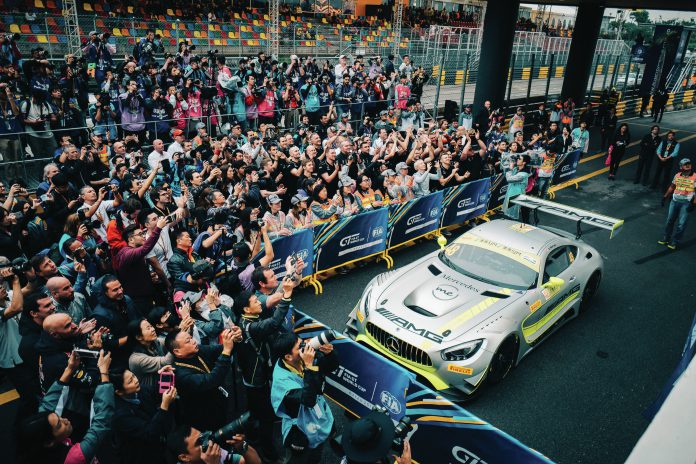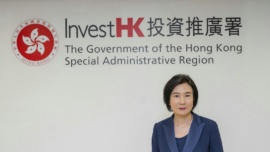The past two editions of the Macau GT Cup – FIA GT World Cup race have been, at the very least, unforgettable. In 2016, Laurens Vanthoor won the annual showdown for GT competitors across the globe despite his Audi R8 lying on its roof when the race was called. In 2017, Edoardo Mortara took his Mercedes-AMG GT to the victory following a massive 16-car pile-up at Police Bend which decimated the field on Saturday’s qualifying race.
These spectacular incidents deflected us from the top racing we have seen on the Guia Circuit, with the world’s top GT drivers and teams. And high-level racing is all we expect from this year’s edition even if the entry list is the smallest since the race was created in 2008. Only 15 cars were entered for the competition, marking a decrease from the record 20-car, seven-manufacturer entry of last year’s event.
The Stéphane Ratel Organisation (SRO), which runs the Blancpain GT Series and all major GT series around the world, was still able to assemble a strong field with GT giants Audi, BMW, Mercedes-AMG, Nissan and Porsche, hosting professional drivers from 11 different countries. SRO plays a key role in co-ordinating the FIA GT World Cup in Macau as it has been appointed by event promoter Associação Geral Automóvel de Macau-China (AAMC) to help bring a grid together for the event since the World Cup’s inception in 2015. The London-based company, however, concedes some disappointment with grid numbers but puts quality over quantity.
“The numbers are indeed lower but the overall quality and manufacturer diversity is strong – Nissan join us for the first time this year with three cars, and with a Hong Kong team, too,” says Benjamin Franassovici, SRO Macau GP Co-ordinator and Blancpain GT Series Asia General Manager. “Then there’s the very high calibre of factory and platinum drivers plus two local stars in Darryl O’Young and Adderly Fong, who know their way around Macau.”
Based upon the successful FIA GT3 technical regulations, the FIA GT World Cup was created four years ago to serve as a showcase for GT manufacturers – an event that absolutely must feature in their record of achievements. The implementation of the FIA Balance of Performance in the management of GT3 racing – which can adjust power, weight, engine management and aerodynamics – ensures a high level of parity across the category. Still, the manufacturers have put a big effort into this race as the Asian market is more important than ever, not only for road cars but racing cars, too. This fierce competition between the car industry giants at Macau has, however, resulted in driving up costs and scaring some of them.
Not helping the cause, the event clashes with a round of the FIA World Endurance Championship for the fourth year, with the 6 Hours of Shanghai scheduled for the same weekend. Fortunately, the FIA was reasonable enough to change the 2019 date of the FA WEC event in Shanghai to avoid this unnecessary clash to happen again next year.
“There are a few things outside of our control, like WEC clashing with the Macau Grand Prix. Even large manufacturers have limited resources, drivers and engineers, and cannot be at two races at once,” adds Franassovici.
 Pros & insurers
Pros & insurers
The Macau GT Cup, established in 2008, was successful from the start and immediately attracted the attention of the world’s leading manufacturers and international GT drivers. Today, the event is reserved for professional drivers (FIA ranked Gold or Platinum), with the FIA prohibiting Bronze and some Silver-rated drivers last year in an effort to improve the quality of the grid.
“The format and entry conditions are both very high with only the world’s best teams and drivers suitable for this most challenging and iconic street circuit,” emphasises Franassovici. “Teams and drivers committing to this event need serious balls.”
Macau racing driver and former Asian SuperCar Challenge champion Rodolfo Avila took part in the Macau GT Cup on five occasions from 2008 to 2014 when interest from local drivers was so high that AAMC had a reserve list of more than a dozen entries.
“Back in 2008 most of the grid was gentleman drivers, and not many GT3 cars were entered,” Avila recalls. “The development of GT racing in Asia and the growth of the GT3 category all over the world helped change the shape of the race. As soon as the manufacturers-supported teams and drivers arrived in force the costs went up and it started to be impossible for a privateer to aim for the top.”
The event that begins with the traditional Tap Seac GT car display the weekend before track activity starts is now almost budget prohibited for non-factory supported entries. The budgets for the weekend, some sources reckon, are well over MOP1 million.
The little interest from the insurance companies, following the past two years of accident-filled races, have also negatively impacted the participation of some private entries. Several sources told Macau Business that the insurers were not that keen to cover MOP4 million cars in full, while not many racers felt the motivation of gambling on the streets of the ‘Las Vegas of the East’.
“That had an impact for sure after last year’s first race,” acknowledges Franassovici. “It did ultimately make a few very interested potential entries think twice.”
All in all, organisers have managed to put up a 15-car grid – four Audi, four Porsche, three Mercedes AMG, three Nissan and one BMW; the minimum per race regulations for the race to be run.
 Hoping for a rise
Hoping for a rise
For a race that has come under increased scrutiny in recent years due to the massive accidents, many will question again if it makes sense to keep the FIA GT World Cup in Macau, a track that leaves zero room for even the slightest error and where a high price is paid for such errors. At least one GT3 manufacturer representative has suggested moving the event to another established venue. The reduced grid will certainly help those who would like to see this race happening elsewhere in the world.
However, SRO seems quite committed to keeping the FIA GT World Cup in Macau in the years to come.
“The numbers are lower than last year but at the high level we’re racing at, realistically twenty is the maximum number for such a high profile GT3 race,” says Franassovici. “Nevertheless, we’ll aim to have twenty-plus cars next year.”
The SRO Macau GP Co-ordinator has reasons to inject some positivism into this subject. There are a few GT3 car manufacturers missing from the grid this year that can come back or debut next year, joining the five automakers of this year’s edition who, for various reasons, are likely to stay.
The most notable absences are 2018 Blancpain GT Series Asia winners Lamborghini, who couldn’t make it this year as its Asian flagship team is preparing their move toEurope at the end of the year; and Honda, for which the GT3 class doesn’t seem a priority. Neither are the British manufacturers represented on the 2018 grid, with Aston Martin and McLaren busy preparing for the launch of new GT3 cars for 2019, while Bentley is currently delivering the first units of its latest version of the Continental GT3 to customer teams.
Meanwhile, a great race weekend is on the cards this month with seven former winners on the Guia Circuit. Macau regulars Edoardo Mortara, Maro Engel, Augusto Farfus Jr, Darryl O’Young, Laurens Vanthoor and Earl Bamber will be joined by former F3 race winner Oliver Jarvis in the race that will be run over two distances – a 12-lap Qualification Race followed by an 18-lap Main Event that will determine this year’s FIA GT World Cup Champion.
























